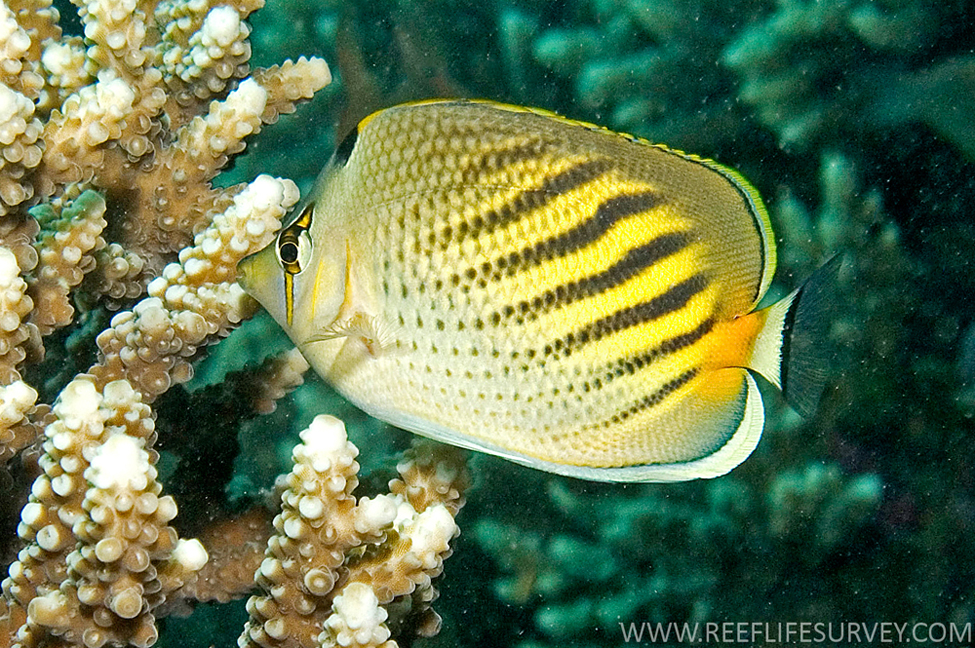Chaetodon is a genus of this
Butterflyfishes

This is the objective of the study
To investigate the bottom-up effects of climate-induced disturbance (mass coral mortality) on reef fishes.
This diagram represents what

Possibilities of dietary overlap in reef fishes.
This graph shows what

Changing dietary preference with coral cover loss in butterflyfish species. Less coral cover= less preference
These are the reasons that we can attribute observed butterflyfish feeding behaviour to coral availability ONLY
1) The warming sea temperatures were not significant enough to affect butterfly fish behaviour- so warming temps not affecting them
2) No predation of butterflyfish was observed- so predators not influencing their behaviour
This occurs when warming seawater temperatures cause coral to turn white and die.

Coral bleaching
These were the years that sampling took place in
2016- warmer temperatures but no bleaching-related death (pre-mortality)
2017- bleaching evident, mass coral mortality (mortality)
2018- two years after bleaching (post-morality)
These were quantified using Hurlbert's Probability of Interspecific Encounter (PIE)
1) Evenness of coral assemblages
2) Evenness of coral being eaten by butterflyfish
Weakened dietary preferences had this effect on butterflyfish niche overlap in 2017 (year of mass coral mortality).
Overlap slightly higher than random, fish switched from the dead Acropora coral to Montipora spp.

This is the recovery time of a bleached coral reef without disturbance.
7-29 years
This genus of hard coral is more sensitive to bleaching than other genera, and is the preferred food source of butterfly fish.
Acropora
This method was used to estimate butterfly fish abundance and coral cover.
A 50m line-transect along the most active part of the coral
1) Counted fish on either side of the transect
2) Identified coral species along the transect
This change in dietary preference happened when food availability decreased (65% of coral cover lost).
Butterflyfish dietary preference decreased.
Weakened dietary preferences had this effect on butterfly niche overlap in 2018 (two years post-bleaching; one year post-mortality)
Decreased overlap; fish now ate a variety of coral genera. Matched random resource use.
This is the average frequency (in years) of coral bleaching events.
Once every 6 years as of 2016
This is the definition of "bottom-up effects".
When changes in food availability cause behavioural changes in predator species.
This was the method used to record butterflyfish diet
- Every bite taken
- The coral species that was bitten
This graph shows what

Evenness of coral assemblages compared to evenness of coral being eaten by butterfly fish.
After bleaching- fish diet is more even (they're less picky in the coral they're eating; eating a wider range of genera)
This graph shows what.

Histogram- niche overlap if random
Black line- niche overlap observed. Here, before bleaching-related mortality there is very high overlap.
Contrary to theoretical expectations, this was the result of weakened dietary preference in butterflyfish on niche overlap
Decrease in niche overlap (competition)
This is the definition of "dietary expansion"
Assuming constant competitor abundance:
When food availability is low, foragers should expand their dietary breadth (they become less picky in what they eat).
Being less picky can lead to increased resource overlap, which may lead to increased competition.
These are the hypotheses of the study
1) Butterflyfish should show weakened dietary preferences (get less picky) in response to less food availability.
- 1a) If large changes in dietary evenness (the fish becoming less picky) are not accompanied by large changes in coral evenness (coral assemblages stay the same), then the fish are changing their dietary preferences.
- 1b) Did loss in coral cover affect individual dietary preference?
2) Weakened dietary preference (fish becoming less picky) should lead to increased dietary overlap and more competition
This graph shows what.

Loss of hard coral cover after bleaching event.
These graphs show what

Niche overlap after coral mortality.
2017- year of coral mortality- very high
2018- 1 year after mortality- very low
These are limitations of looking at the short-term effects after coral bleaching
Butterflyfish are long-lived, we don't know if:
1) They'll maintain dietary flexibility for long
2) Future generations will be affected
3) Continued coral mortality will decrease overall availability of food and cause population decline in the future